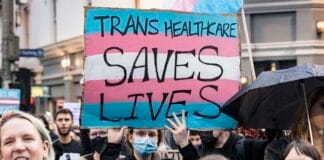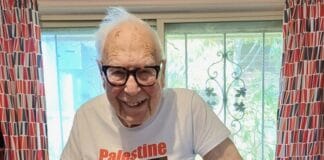In November 1982, the first case of AIDS was diagnosed in Australia. In the 1980s, life expectancy for those diagnosed with AIDS was three years. Geraldine Fela’s new book tells the story of the nurses on the frontline of the response. She spoke with Solidarity’s David Glanz.
Can you describe the impact of AIDS and the moral panic at the time?
AIDS hit in the aftermath of the gay liberation movement in Australia and brought with it a very vicious backlash. Initially the main people affected by HIV or AIDS were gay men. It seemed to a lot of people to confirm homophobic ideas that there was something sick or perverted about gay people.
In the peak years of the crisis around 7000 people died of AIDS or AIDS-related illnesses, the vast majority of them gay men.
People suddenly became sick with terrible cancers or pneumonia, and would very quickly waste away and die. Extraordinary advances in treatment mean people with HIV now live full, healthy lives. You can have HIV and have a zero viral load, which means that you can’t transmit the virus.
But at the time for lots of people it was a death sentence. It had a terrible impact on a very small and tight knit community.
What happened when the reality of caring for patients with AIDS ran up against the medical hierarchy?
Hospitals were, and to a large extent still are, very hierarchical workplaces. Florence Nightingale, who was a nurse during the Crimean War, developed a framework of nursing that was based around Victorian ideas of womanhood. The British Empire spread it around the world.
This resulted in a strict gendered division of labour in hospitals. Nurses weren’t all women in the 1980s and 1990s, but you still had this masculinised figure of the doctor that dealt in hard facts and medication, and the nurse, paid substantially less and performing lower status care work.
In the context of HIV, though, doctors could do almost nothing.
The care that nurses gave became more important. Even more important was that the patients didn’t subscribe to hierarchical ideas of how hospitals should run. They were young people who had come through the 1970s, a lot of them involved in the gay liberation movement. They pushed back, demanding a say in their treatment.
The elevated role of nurses combined with the growing industrial militancy of nurses’ unions had a transformative effect on the kind of healthcare that was provided.
What else was going on to shape the way in which nurses felt that they could actually have a say?
Nursing had moved from hospital-based training into universities. Nurses had also been exposed to the social movements of the 1970s, for Black liberation and land rights, women’s liberation and gay liberation.
They had much more radical ideas about how people should be treated and how hospitals should be run.
At the same time, there was an explosion of industrial militancy. The organisations that represented nurses historically often hadn’t been affiliated with the trade union movement. For example, in Victoria, the nurses had a professional association that wasn’t affiliated to Trades Hall until the late 1970s.
Nurses’ unions started fighting for better conditions and better wages, but they were also pushing back against their subordinate role in the healthcare system.
This radical rank-and-file elected leaders that reflected their politics, people like Irene Bolger in Victoria, Jenny Haines and Bronwyn Ridgway in NSW.
Nurses’ unions provided crucial leadership to shaping a public health response that was about empowering communities themselves to respond to the problem.
Doctors and surgeons wanted hospitals to profile people based on whether they thought that they might have AIDS, which meant profiling gay men or drug users or sex workers, and forcing those people to undergo tests before they would deliver any treatment. This would have been a huge barrier to accessing treatment, and extraordinarily humiliating and discriminatory.
Nurses’ unions in NSW and Victoria in particular led the way in opposing compulsory testing in hospitals, and fighting for universal precautions.
Nurses fought for an attitude that you treat every single person who comes into a hospital as if they might have HIV. That is now the absolute common sense way that hospitals deal with all infectious diseases.
In early 1992, the AIDS working group of the Australian Nursing Federation held a conference.
In that conference the nurses put a motion that said we will not participate in compulsory testing of a single patient. This was an example of nurses threatening a work ban for the rights of patients with HIV and for the rights of patients from affected communities.
Doctors and surgeons also wanted to quarantine people with the virus. That happened in parts of the world, Cuba for example, with compulsory testing of communities considered at risk and people put under public health orders controlling their movement.
Elements of that did take place in Australia. Mass compulsory testing was used in Aboriginal communities. Prisoners were subject to compulsory HIV testing. And there were individuals, often people engaged in sex work or injecting drug users, who were put under public health orders that controlled their movements.
But that was not the overarching story of the response. Another path was taken, which was about giving communities the information and the tools that they needed to control the spread of the virus.
Money was poured into AIDS councils, which were gay community-led organisations that distributed frank, sex positive information about how to stop the spread of the virus. Needle exchanges were established, which at the time were illegal, to stop the transmission of the virus through injecting drug use. Similarly, there were outreach programs funded for sex workers. This meant that in Australia, unlike the US, HIV never spread substantially beyond the gay community.
The gay community fought for this. And nurses and their unions backed them, and were crucial in providing some industrial muscle to win it.
The nurses’ unions also did educational work within their membership.
HIV was shrouded in panic and fear at the time. Most people didn’t really understand how it was transmitted. The nurses’ union spread that information to their membership in a really effective way.
Tragically COVID was the exact opposite of the HIV response. We weren’t given information to help stop the spread ourselves. Instead, we had a punitive, coercive response to the virus.
We saw this in Melbourne with the public housing tower lockdowns, where people were imprisoned in their homes for months on end through rolling quarantine. The result, I think, will be terrible years down the track, with trust in accessing healthcare severely diminished.
First Nations people were seen as being particularly at risk of dying from AIDS. Tell us about the work of Aunty Gracelyn Smallwood and others in helping Indigenous communities protect themselves.
When HIV first started spreading, there were people in the medical establishment saying it would be the end of Indigenous Australia.
Indigenous communities rejected that and said, no, we can find solutions. Auntie Gracelyn Smallwood, a Birrigubba, Kalkadoon and South Sea Islander woman, helped establish the first Aboriginal and Torres Strait Islander controlled medical service in Townsville in the late 1970s. She was influenced by the Land Rights and Black Power movements and the politics of self-determination and community control that came with them.
When HIV emerged, she went around helping community health services develop responses to HIV around health promotion. The most famous example was Condoman, the First Nations superhero who was all over posters. His line was, don’t be ashamed to use condoms.
That campaign was developed at a workshop that Aunty Gracelyn and other Aboriginal healthcare workers ran in Townsville with people from the community. They developed a health promotion campaign that spoke directly to their communities with a really clear safe sex message.
Importantly it cast First Nations people as the solution in responding to the virus, not just potential victims. That response was replicated in community controlled health organisations across the country.
Today, the rate of HIV in Indigenous communities is on a par with the non-Indigenous community. The social oppression that Aboriginal and Torres Strait Islander people face means that for many transmissible viruses, that’s not the case.
How were nurses and others able to fight back against the rampant homophobia that characterised Australia in the 1980s?
Nurses played an important role as part of initiatives that gay community organisations took to confront and challenge homophobia. They ran workshops and speaking tours through union branches of HIV positive nurses to dispel some of the myths and fears people had about the virus.
There are also some horrible stories. There are countless examples that people gave me, particularly in hospitals outside Sydney and Melbourne, where the nurse unit manager would say, ‘who wants to look after this person? They’ve got AIDS’, and 50 per cent of the room would say, not me. I had one nurse tell me that when she was caring for a man with AIDS, the other nurses asked her to use a different toilet.
There were other nurses who stood up and challenged that.
Sometimes the leadership of the union might have a very good progressive policy on HIV, but what actually happened at the hospital was down to the rank-and-file and their ability to carry it out.
Where you had a strong political rank-and-file, who were often influenced by the gay liberation movement or social movements more generally, you had that policy put into practice and homophobia pushed back.
One of the lessons is the power and the importance of the rank-and-file.





